
An oak is a hardwood tree or shrub in the genus Quercus of the beech family, Fagaceae. They have spirally arranged leaves, often with lobed edges, and a nut called an acorn, borne in a cup. The genus is widely distributed in the Northern Hemisphere; it includes some 500 species, both deciduous and evergreen. Fossil oaks date back to the Middle Eocene. Molecular phylogeny shows that the genus is divided into Old World and New World clades, but many oak species hybridise freely, making the genus's history difficult to resolve.

Galls or cecidia are a kind of swelling growth on the external tissues of plants, fungi, or animals. Plant galls are abnormal outgrowths of plant tissues, similar to benign tumors or warts in animals. They can be caused by various parasites, from viruses, fungi and bacteria, to other plants, insects and mites. Plant galls are often highly organized structures so that the cause of the gall can often be determined without the actual agent being identified. This applies particularly to some insect and mite plant galls. The study of plant galls is known as cecidology.

Quercus douglasii, known as blue oak, is a species of oak endemic to California, common in the Coast Ranges and the foothills of the Sierra Nevada. It is California's most drought-tolerant deciduous oak, and is a dominant species in the blue oak woodland ecosystem. It is occasionally known as mountain oak and iron oak.
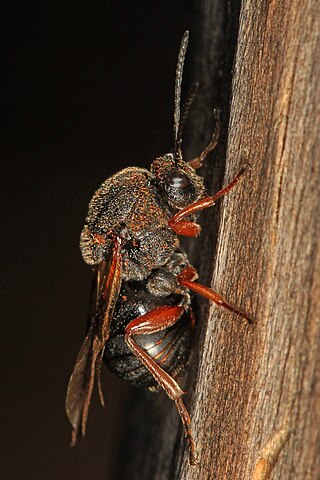
Gall wasps, also traditionally calledgallflies, are hymenopterans of the family Cynipidae in the wasp superfamily Cynipoidea. Their common name comes from the galls they induce on plants for larval development. About 1,300 species of this generally very small creature are known worldwide, with about 360 species of 36 different genera in Europe and some 800 species in North America.

Quercus coccinea, the scarlet oak, is a deciduous tree in the red oak section Lobatae of the genus Quercus, in the family Fagaceae.
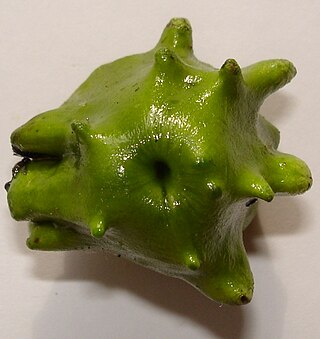
Andricus quercuscalicis is a gall wasp species inducing knopper galls.

Andricus kollari, also known as the marble gall wasp, is a parthenogenetic species of wasp which causes the formation of marble galls on oak trees. Synonyms for the species include Cynips kollari, Andricus quercusgemmae, A. minor, A. indigenus and A. circulans.

Andricus foecundatrix is a parthenogenetic gall wasp which lays a single egg within a leaf bud, using its ovipositor, to produce a gall known as an oak artichoke gall, oak hop gall, larch-cone gall or hop strobile The gall develops as a chemically induced distortion of leaf axillary or terminal buds on pedunculate oak or sessile oak trees. The larva lives inside a smaller hard casing inside the artichoke and this is released in autumn. The asexual wasp emerges in spring and lays her eggs in the oak catkins. These develop into small oval galls which produce the sexual generation of wasps. A yew artichoke gall caused by the fly Taxomyia taxi also exists, but is unrelated to the oak-borne species. Previous names or synonyms for the species A. fecundator are A. fecundatrix, A. pilosus, A. foecundatrix, A. gemmarum, A. gemmae, A. gemmaequercus, A. gemmaecinaraeformis and A. quercusgemmae.
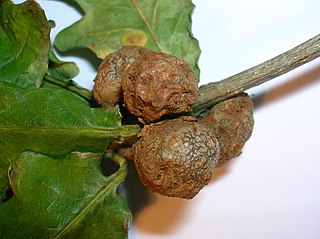
Cola-nut galls develop as a chemically induced distortion of leaf axillary or terminal buds on pedunculate oak or sessile oak trees, caused by the agamic gall wasp Andricus lignicola which lays single eggs within leaf buds using their ovipositor. A previous name or synonym for the species A. lignicola is A. lignicolus and A. venheurni.

Andricus is a genus of oak gall wasps in the family Cynipidae.

Andricus grossulariae is a gall wasp species inducing agamic acorn cup galls on oak tree acorn cups and sexual phase galls on catkins. Synonyms include Andricus fructuum, Andricus gemellus, Andricus intermedius, Andricus mayri and Cynips panteli.
Bassettia is a genus of gall wasps found in North America.

Callirhytis is a genus of gall wasps in the family Cynipidae. There are more than 90 described species in Callirhytis.
Andricus mukaigawae is a species of gall wasp native to southeastern Asia. It creates galls on the buds and leaves of oak trees. The galls are sometimes used by other gall wasps unable to create galls of their own, with both species sharing the gall.
Callirhytis seminator, the wool sower, is a species of gall wasp in the family Cynipidae.

Callirhytis quercussuttoni, the gouty stem gall wasp, is a species of gall wasp. Its galls appear on oaks in the red oak group on the west coast of North America.
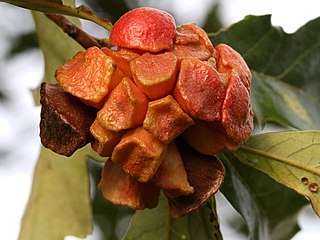
Andricus quercusstrobilanus, the lobed oak gall wasp, is a species of gall wasp in the family Cynipidae, found in North America. The quercus in its specific name is the genus name for oak, while "strobilus" is derived from the Greek strobilo which means "cone", a reference to the cone shape of the gall; thus the gall is sometimes called pine cone oak gall.
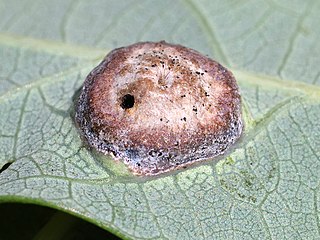
Callirhytis quercusfutilis, the oak wart gall wasp, is a species of gall wasp in the family Cynipidae.

Callirhytis quercusagrifoliae, commonly known as the bud gall wasp, is a species of hymenopteran that induces galls on the flower buds of coast live oaks and interior live oaks. This wasp has been observed in California in North America.
















